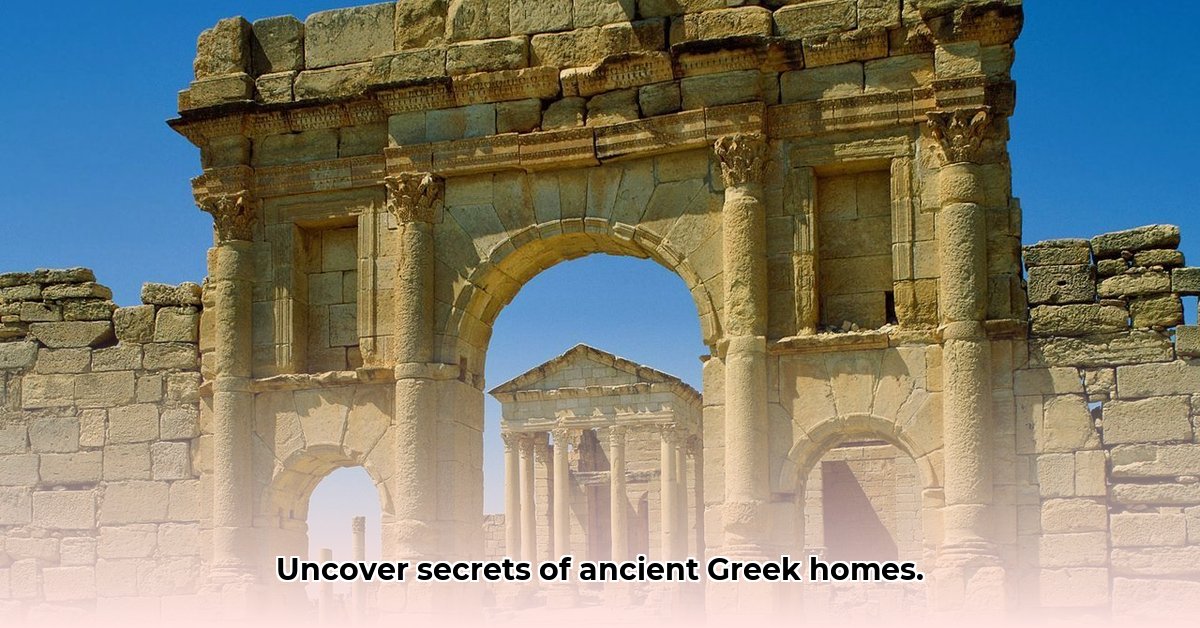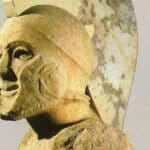Ever been curious about life in ancient Greece? Exploring a typical Greek home offers a captivating glimpse into the daily lives of everyone from farmers to aristocrats. It’s more than just ruins; it’s understanding daily routines, building methods, and how people interacted. These homes reveal a great deal about how they lived, worked, and prospered. To visualize their locations, check out this Ancient Greece map.
Discovering Ancient Greek Homes and Daily Life
Exploring ancient Greek homes opens a portal into the lives, social structures, and remarkable skills of this civilization. These houses weren’t mere shelters; they were the center of the oikos (household), wielding significant economic and social influence. What can we uncover by examining these ancient dwellings?
Variety of Homes: From Modest Residences to Luxurious Mansions
For the average citizen, a simple mud-brick home with a thatched roof offered refuge from the Mediterranean sun. In stark contrast, the wealthy enjoyed grand stone houses adorned with intricate carvings and mosaic floors. This disparity underscores the social divide in ancient Greece. The size, materials, and embellishments directly reflected wealth and status. Yet, both types showcased ingenious climate adaptation techniques.
The Courtyard: A Vibrant Hub of Social Life
The aule, or courtyard, stood as the focal point in nearly every ancient Greek home, regardless of size. More than just decorative, it served as the functional heart of the house. Sunlight and natural air circulation provided cooling in the warm climate. Families shared meals, crafted goods, and exchanged news here—it was the family’s living room, kitchen, and workspace all in one.
Reflecting Societal Norms: Gendered Spaces and Social Roles
Many ancient Greek houses mirrored the social norms of the time in their layouts. The andron, the men’s area, often located near the entrance, symbolized their public role and was used for entertaining male guests. The gynaeceum, the women’s space, situated further inside, reflected their traditional domestic responsibilities, where they managed the household and raised children. Archaeological evidence suggests the spatial separation was significant, reinforcing the divide between public and private spheres, although interpretations continue to evolve.
Building Resourcefully: The Significance of Materials
The materials used in construction reveal stories of resourcefulness and social standing. Affordable mud brick was a common choice, especially in rural areas. Stone, more durable and prestigious, signified wealth and was used for foundations and walls. Wood supported beams and roofs but required sustainable sourcing.
Immersing in Daily Life: Sounds, Smells, and Routines
What was it like to live in an ancient Greek house? Mornings likely began with simple meals prepared in the courtyard, filled with chatter and the aroma of fresh bread. Days might involve weaving, pottery, or agricultural work, depending on the family’s occupation. Evenings concluded with shared meals, either in the andron or gynaeceum, depending on gender and social role.
Sanitation Systems: Managing Waste in Ancient Times
One intriguing aspect is the absence of sophisticated plumbing. Waste disposal was a daily challenge handled through simpler methods, such as chamber pots, and regular courtyard cleaning. Hygiene practices differed markedly from modern standards, raising questions about daily routines and sanitation.
Wisdom in Design: Lessons in Sustainable Architecture
Studying ancient Greek architecture offers valuable lessons in sustainable design and resource management. The courtyard’s ventilation systems, strategic orientation, and use of local materials remain relevant today, inspiring architects and engineers to create sustainable and efficient constructions.
Ongoing Discoveries: Unveiling Ancient Secrets
Many questions about ancient Greek houses remain unanswered. Ongoing excavations and technological advancements promise to reshape our understanding further. Each discovery brings us closer to a complete picture of life in ancient Greece, with ongoing research exploring new interpretations of spatial organization based on emerging evidence.
Types of Ancient Greek Houses: A Summary
| House Type | Materials | Inhabitants | Characteristics |
|---|---|---|---|
| Simple Dwelling | Mud brick, thatch | Common citizens | Small, basic, courtyard central |
| Wealthy Residence | Stone, marble, wood | Wealthy families | Larger, elaborate, multiple rooms, andron, gynaeceum, mosaics |
| Rural Farmhouse | Local stone, wood, clay | Farmers, agricultural workers | Practical layout, storage for produce, animal pens nearby |
There’s still much to learn about ancient Greek houses and their inhabitants. Delve deeper into their construction, the lives of those who dwelled within, and the broader cultural context.
Ventilation Techniques: Applying Ancient Greek Strategies Today
Imagine standing in an Athenian courtyard, feeling the gentle breeze. This wasn’t accidental; it was the result of sophisticated design. Ancient Greek architects were masters of passive cooling—techniques we can adapt for sustainable living today.
Ancient Greek Ventilation: Understanding the Principles
Ancient Greek homes incorporated ingenious ventilation systems. The andron, often located near courtyards, acted as natural lungs, drawing in cool air and expelling warm air. Strategic window and door placement created cross-ventilation, an effective method. Houses often maximized prevailing breezes, taking advantage of the local climate.
High ceilings and multiple levels also promoted air circulation. Hot air rose, creating a more comfortable environment. These principles provided remarkable climate control, minimizing the need for artificial cooling.
Replicating Ancient Wisdom: Modern Sustainable Designs
Translating this ancient knowledge into modern designs involves understanding and creatively applying the underlying principles.
- Courtyards and Atria: Creating central open spaces promotes natural airflow, reducing reliance on mechanical systems. This can be adapted for smaller homes or apartment buildings.
- Strategic Window Placement: Careful window and door positioning maximizes cross-ventilation by harnessing prevailing wind patterns. Consider awning windows to encourage airflow even during light rain.
- Building Orientation: Orienting a building to minimize direct sunlight can significantly reduce reliance on heating and cooling systems. Use shading devices like pergolas or trellises.
- Thermal Mass: Materials like concrete, brick, or rammed earth can absorb and slowly release heat, moderating indoor temperatures. This is especially effective in climates with large temperature swings.
- High Ceilings and Open Floor Plans: These encourage natural convection, similar to ancient Greek houses. Lofts or mezzanine levels can further enhance air circulation.
Adapting for Modern Contexts: Sustainable Materials and Technologies
Implementing these principles requires ingenuity, especially in urban settings. Sustainable materials like reclaimed wood, bamboo, or recycled concrete can further enhance energy efficiency. Combine ancient techniques with modern technologies like smart home systems for optimal climate control.
Key Takeaways:
- Passive ventilation is highly effective, as demonstrated by the Ancient Greeks.
- Modern adaptations are achievable using historical principles creatively.
- Sustainable materials are essential for energy efficiency and environmental responsibility.
- Strategic building orientation maximizes solar gain in winter and minimizes it in summer.
- Even smaller courtyards or light wells can make a significant difference in ventilation and natural light.
Ancient Greek House Designs: Materials, Layout, and Social Significance
Key Takeaways:
- Ancient Greek homes centered around a courtyard, emphasizing functionality and social interaction.
- Materials reflected wealth and status, ranging from mud-brick to stone and marble.
- Distinct spaces existed for men and women (andron and gynaeceum), though the degree of separation is continually debated.
- Sanitation was rudimentary, highlighting the daily life challenges.
- The “oikos” encompasses the social, economic, and familial context of the household.
Immersing in the Past: Daily Life and Ancient Homes
Visiting an ancient Greek village reveals a spectrum of dwellings, from modest residences to grand mansions, reflecting society’s social hierarchy.
Building a Home: The Significance of Materials and Construction
The choice of building materials spoke volumes about prosperity. Sun-baked mud-brick was affordable and readily available, while wealthier citizens could afford stone or marble. Masons and architects played a crucial role in shaping the landscape.
The Layout of Life: Courtyards and Compartments
Most Greek houses featured a central courtyard (aule), the heart of family life. Separate quarters, the andron and gynaeceum, existed, though the degree of separation is continually debated among scholars. Space was often used efficiently, with rooms serving multiple functions depending on the time of day.
Social Structures: Gender and Class Dynamics
Domestic architecture reflected societal structures, with divisions indicating the roles of men and women. The size, complexity, and ornamentation of the house directly reflected the family’s wealth and status within the community.
Everyday Life: Basic Amenities and Survival
A striking aspect of ancient Greek houses is the lack of advanced plumbing and sanitation. Chamber pots and communal facilities were common, highlighting the realities of sanitation in ancient Greece. Water had to be fetched from wells or public fountains.
Social Class in Ancient Greek Houses
Comparing Ancient Greek Houses Across Social Classes, Regions, and Eras
Exploring ancient Greek homes reveals a rich tapestry of architectural styles and social dynamics. These dwellings varied significantly based on social class, region, and the period in which they were built.
Oikos: The Core of Domestic Life
The oikos shaped family life and mirrored the wealth and status of its inhabitants. The courtyard served as the hub of daily activities, sometimes containing an altar dedicated to Hestia, goddess of the hearth.
Class Matters: Architecture and Social Standing
House size, materials, and decoration reflected the owner’s social standing. Wealthy citizens had elaborate stone mansions adorned with mosaics and frescos, while poorer citizens lived in simpler mud-brick dwellings. Regional variations also existed, with distinct differences between houses in Athens, Sparta, and Delos, showcasing various traditions and architectural preferences.
Gender Perspectives: Andron and Gynaeceum
Layouts often reflected societal roles. The andron served as a reception area for male guests and a space for symposia, while the gynaeceum was the women’s domain, encompassing private rooms and areas for weaving and other domestic tasks. Understanding the nuances of domestic arrangements requires careful comparison across these factors and regions.
Time and Evolution: Architectural Shifts Throughout History
Ancient Greek architecture evolved over centuries, influenced by technological advancements, cultural exchanges, and societal changes. Early houses were simpler in design, while later periods showcased more elaborate structures, including self-sufficient wealthy households integrated into broader economic systems. Trade connections and the types of goods found within these homes reveal intricate commercial networks.
Key Learning Points: Understanding Social Complexity
- Ancient Greek houses, or oikoi, were central to social, economic, and family life.
- House design varied considerably by social class, region, and time period.
- The courtyard, andron, and gynaeceum reveal much about gender roles and social organization.
- Most households, to varying degrees, relied on external economic networks.
- Comparing across social classes, regions, and time periods provides a nuanced perspective on ancient Greek society and domestic life.
[1]: Ault, B. A., & Nevett, L. C. (Eds.). (2006). Ancient Greek Houses and Households: Chronological, Regional, and Social Diversity. Oxford University Press.
- Ancient Greece Aristocracy: Rise and Fall of Power - August 9, 2025
- Rediscover the Bad Girls of Ancient Greece: A Feminist Retelling - August 9, 2025
- Discover Ancient Greece Weapons: A Comprehensive Guide to Military Technology - August 8, 2025
















